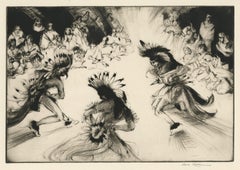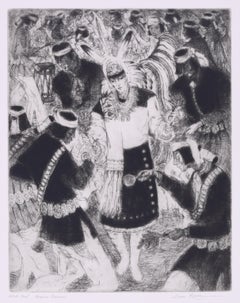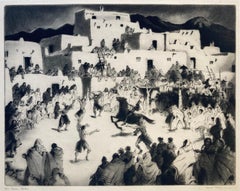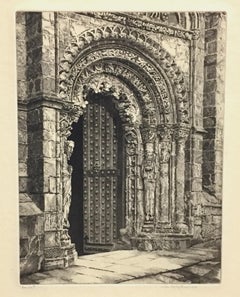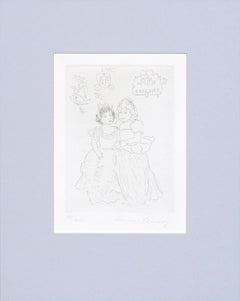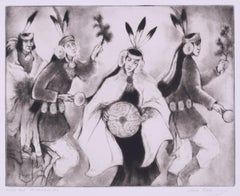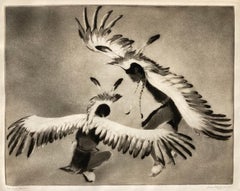Gene Kloss Figurative Prints
American, 1903-1996
Gene (Alice Geneva) Kloss is considered one of America’s master printmakers. She was born in Oakland, California and established herself as an artist on the West coast.
Kloss was introduced to etching by Perham Nahl while at UC Berkley. She graduated in 1924, and in 1925 married poet Phillips Kloss. In her late twenties, Kloss moved to Taos, New Mexico and began her life’s work of the New Mexican landscape and peoples. It was at this time that she received national acclaim.
Her artwork exudes an unmistakable content and style. Enchanted by the architecture, mountainous landscapes and rituals of the inhabitants, Kloss captured the beauty of the Southwest and surrounding areas. Her style was bold yet deftly simple, masterfully expressing the elusive Southwestern light.
In 1938, she exhibited in Paris with Ernest Blumenschein, Georgia O’Keeffe, and John Sloan. She was also a member of the National Academy of Design, New York.to
3
Overall Width
to
Overall Height
to
13
830
375
361
308
3
1
1
1
2
1
2
2
1
1
1
1
1
1
2
2
1
1
3
Artist: Gene Kloss
Indian Friendship Dance
By Gene Kloss
Located in Fairlawn, OH
Indian Friendship Dance
Drypoint, 1953
Signed in pencil lower right, (see photo)
Edition 200
Published by The Society of American Graphic Artists, New York
An impression is in the collection of SAAM, Washington and RISD Museum,
Condition: Excellent
Very rich impression with burr and selective whiping of the ink for atmospheric nocturnal effect.
Image/Plate size: 8 3/16 x 11 15/16 inches
Sheet size: 11 1/8 x 17 inches
Reference: Kloss 450
"'Indian Friendship Dance' is an eloquent statement of something which Gene Kloss has both observed and participated in. It is an Indian dance that is thought of as entertainment, rather than ceremony, but it is essentially an idea expressed in action, and an idea that has universal meaning. The young men who dance wear costumes of exquisite workmanship, intricately wrought with beads and feathers and subtle combinations of colors. The dancers are trained from childhood but develop their own steps and exhibit distinctive strength and grace. Singers and a tom-tom accompany the dance and since it usually takes place at night, a campfire is the source of light. The conclusion occurs when all the onlookers, old and young and from many places, join hands with the dancers in a slow revolving movement, while those who can, sing the difficult but meaningful Indian song that flows with the rhythmical dance step and speaks of fellowship, brotherhood, friendship." - An excerpt from a descriptive statement, written by Lynd Ward, and distributed with the drypoint at the time of publication." Courtesy Old Print Shop
Born Alice Glasier in Oakland, CA, Kloss grew up amid the worldly bustle of the San Francisco Bay Area. She attended the University of California at Berkeley, graduating with honors in art in 1924. She discovered her talents in intaglio printmaking during a senior-year course in figurative drawing. The professor, Perham Nahl, held up a print from Kloss’ first plate, still damp from the printing process, and announced that she was destined to become a printmaker.
In 1925, Gene married Phillips Kloss, a poet and composer who became her creative partner for life. The match was uncanny, for in her own way Gene, too, was a poet and a composer. Like poetry, her artworks capture a moment in time; like music, her compositions sing with aesthetic harmony. Although she was largely self-taught, Kloss was a printmaking virtuoso.
On their honeymoon the Klosses traveled east from California, camping along the way. They spent two week is Taos Canyon – with a portable printing press cemented to a rock near their campsite – where Gene learned to appreciate the wealth of artistic subject matter in New Mexico. The landscape, the cultures, and the immense sky left an indelible impression on the couple, who returned every summer until they made Taos their permanent home 20 years later.
Throughout her life, Kloss etched more than 625 copper plates, producing editions ranging from five to 250 prints. She pulled every print in every edition herself, manually cranking the wheel of her geared Sturges press until she finally purchased a motorized one when she was in her 70s. Believing that subject matter dictated technique, she employed etching, drypoint, aquatint, mezzotint, roulette, softground, and a variety of experimental approaches, often combining several techniques on the same plate. She also produced both oil and watercolor paintings.
Kloss’ artworks are filled with drama. Her prints employ striking contrasts of darkness and light, and her subjects are often illuminated by mysterious light sources. Though she was a devout realist, there is also a devout abstraction on Kloss’ work that adds an almost mythical quality.
For six decades Kloss documented the cultures of the region-from images of daily life to those of rarely seen ceremonies. She and her husband shared a profound respect for the land and people, which made them welcome among the Native American and Hispanic communities. Kloss never owned a camera but relied instead on observation and recollection. Her works provide an inside look at the cultures she depicted yet at the same time communicate the awe and freshness of an outsider’s perspective.
Although Kloss is best known for her images of Native American and Penitente scenes, she found artistic inspiration wherever she was. During the early years of their marriage, when she and Phil returned to the Bay Area each winter to care for their aging families, she created images of the California coast. And when the Klosses moved to southwestern Colorado in 1965, she etched the mining towns and mountainous landscapes around her.
In 1970 the Klosses returned to Taos and built a house north of town. Though her artwork continued to grow in popularity, she remained faithful to Taos’ Gallery A, where she insisted that owner Mary Sanchez keep the prices of her work reasonable regardless of its market value. Kloss continued to etch until 1985, when declining health made printmaking too difficult.
From her first exhibition at San Francisco’s exclusive Gump’s in 1937 to her 1972 election to full membership in the National Academy of Design, Kloss experienced a selective fame. She received numerous awards, and though she is not as well known as members of the Taos Society of Artists...
Category
1950s American Realist Gene Kloss Figurative Prints
Materials
Drypoint
Keresan Dancers
By Gene Kloss
Located in Fairlawn, OH
Keresan Dancers
Etching & drypoint, 1962
Signed lower right (see photo)
Inscribed lower left: "Artist's Proof Keresan Dancers"
Depicts Keresan speaking peoples at Sam Felipe Pueblo
Contemporary Puebloans are customarily described as belonging to either the eastern or the western division. The eastern Pueblo villages are in New Mexico along the Rio Grande and comprise groups who speak Tanoan and Keresan languages. Tanoan languages such as Tewa are distantly related to Uto-Aztecan, but Keresan has no known affinities. The western Pueblo villages include the Hopi villages of northern Arizona and the Zuni, Acoma, and Laguna villages, all in western New Mexico.
Born Alice Glasier in Oakland, CA, Kloss grew up amid the worldly bustle of the San Francisco Bay Area. She attended the University of California at Berkeley, graduating with honors in art in 1924. She discovered her talents in intaglio printmaking during a senior-year course in figurative drawing. The professor, Perham Nahl, held up a print from Kloss’ first plate, still damp from the printing process, and announced that she was destined to become a printmaker.
In 1925, Gene married Phillips Kloss, a poet and composer who became her creative partner for life. The match was uncanny, for in her own way Gene, too, was a poet and a composer. Like poetry, her artworks capture a moment in time; like music, her compositions sing with aesthetic harmony. Although she was largely self-taught, Kloss was a printmaking virtuoso.
On their honeymoon the Klosses traveled east from California, camping along the way. They spent two week is Taos Canyon – with a portable printing press cemented to a rock near their campsite – where Gene learned to appreciate the wealth of artistic subject matter in New Mexico. The landscape, the cultures, and the immense sky left an indelible impression on the couple, who returned every summer until they made Taos their permanent home 20 years later.
Throughout her life, Kloss etched more than 625 copper plates, producing editions ranging from five to 250 prints. She pulled every print in every edition herself, manually cranking the wheel of her geared Sturges press until she finally purchased a motorized one when she was in her 70s. Believing that subject matter dictated technique, she employed etching, drypoint, aquatint, mezzotint, roulette, softground, and a variety of experimental approaches, often combining several techniques on the same plate. She also produced both oil and watercolor paintings.
Kloss’ artworks are filled with drama. Her prints employ striking contrasts of darkness and light, and her subjects are often illuminated by mysterious light sources. Though she was a devout realist, there is also a devout abstraction on Kloss’ work that adds an almost mythical quality.
For six decades Kloss documented the cultures of the region-from images of daily life to those of rarely seen ceremonies. She and her husband shared a profound respect for the land and people, which made them welcome among the Native American and Hispanic communities. Kloss never owned a camera but relied instead on observation and recollection. Her works provide an inside look at the cultures she depicted yet at the same time communicate the awe and freshness of an outsider’s perspective.
Although Kloss is best known for her images of Native American and Penitente scenes, she found artistic inspiration wherever she was. During the early years of their marriage, when she and Phil returned to the Bay Area each winter to care for their aging families, she created images of the California coast. And when the Klosses moved to southwestern Colorado in 1965, she etched the mining towns and mountainous landscapes around her.
In 1970 the Klosses returned to Taos and built a house north of town. Though her artwork continued to grow in popularity, she remained faithful to Taos’ Gallery A, where she insisted that owner Mary Sanchez keep the prices of her work reasonable regardless of its market value. Kloss continued to etch until 1985, when declining health made printmaking too difficult.
From her first exhibition at San Francisco’s exclusive Gump’s in 1937 to her 1972 election to full membership in the National Academy of Design, Kloss experienced a selective fame. She received numerous awards, and though she is not as well known as members of the Taos Society of Artists...
Category
1960s American Realist Gene Kloss Figurative Prints
Materials
Drypoint
TAOS INDIAN JESTERS
By Gene Kloss
Located in Santa Monica, CA
GENE KLOSS (1903 – 1996)
TAOS INDIAN JESTERS, 1944
Etching and aquatint, Signed and titled in pencil. Edition 30. Image 11” x 13 7/8”, sheet 13 ¼ x 16 ½”. In very good condition sa...
Category
1940s American Realist Gene Kloss Figurative Prints
Materials
Etching, Aquatint
Related Items
John Taylor Arms, Study in Stone, Cathedral of Ourense
By John Taylor Arms
Located in New York, NY
John Taylor Arms was known for making such finely drawn etchings that commercial tools were not good enough: He regularly used sewing needles with corks ...
Category
Mid-20th Century American Realist Gene Kloss Figurative Prints
Materials
Etching
Figurative Etching of Two Girls in Gowns, Line Drawing
By Dorian Krausz
Located in Soquel, CA
Delicate drypoint etching of two girls by Dorian Krausz (American, b. 1948). Signed "Dorian Krausz" in the lower right corner. Numbered "196/300" in the lower left corner. Presented ...
Category
Late 20th Century Contemporary Gene Kloss Figurative Prints
Materials
Paper, Ink, Drypoint
$372 Sale Price
20% Off
H 14 in W 11 in D 0.25 in
PHOEBE PASSES MY GATE
Located in Portland, ME
Hutty, Alfred. PHOEBE PASSES MY GATE.
Drypoint, c. 1931. Edition size c.75.
8 1/8 x 7 1/4 inches (plate), 10 1/4 x 8 3/4 inches (sheet).
Print...
Category
1930s American Realist Gene Kloss Figurative Prints
Materials
Drypoint
Erotic Scene - Etching by Mino Maccari - Mid-20th Century
By Mino Maccari
Located in Roma, IT
Erotic Scene is an Etching and Drypoint realized by Mino Maccari in the Mid-20th Century.
Hand-signed in the lower part.
Good conditions.
Mino Maccari (Siena, 1924-Rome, June 16, ...
Category
Mid-20th Century Modern Gene Kloss Figurative Prints
Materials
Paper, Etching, Drypoint
$394
H 10.24 in W 8.27 in D 0.04 in
"End of Day" Original Limited Edition Etching
Located in Soquel, CA
"End of Day" Original Limited Edition Etching by John McGrath (Irish/American b.1884 d.1942).
This etching depicts a man with a tool slung over his shoulder walking along a path th...
Category
Early 20th Century American Realist Gene Kloss Figurative Prints
Materials
Paper, Ink, Drypoint, Etching
'Tree, Manhattan' — Classic American Realism
By Martin Lewis
Located in Myrtle Beach, SC
Martin Lewis, 'Tree, Manhattan', drypoint, 1930, edition 91 (including 10 trial proofs), McCarron 87. Signed in pencil. A superb, atmospheric impression, in warm black ink, on cream...
Category
1930s American Realist Gene Kloss Figurative Prints
Materials
Drypoint
A view of the New York Public Library, looking uptown along 5th Avenue.
Located in Middletown, NY
New York: c 1920.
Etching with aquatint printed in brownish black ink on cream wove paper, 8 3/4 x 12 inches (220 x 304 mm), full margins. Signed and titled in pencil in the lower ma...
Category
1920s American Modern Gene Kloss Figurative Prints
Materials
Archival Paper, Etching, Aquatint
$400
H 8.67 in W 11.97 in
Rothenberg
Located in Middletown, NY
Etching with aquatint on cream wove paper, 6 11/16 x 9 15/16 inches (170 x 252 mm), full margins. Signed in pencil in the lower right margin. With significant toning and moderate mat...
Category
Early 20th Century Naturalistic Gene Kloss Figurative Prints
Materials
Handmade Paper, Etching, Aquatint
The Fish Market
Located in Middletown, NY
Etching with drypoint and aquatint on laid Japon paper, 9 x 11 1/4 inches (228 x 280 mm); sheet 11 7/8 x 13 5/8 (302 x 346 mm), full margins. Signed, titled and inscribed "To my dear...
Category
Mid-20th Century American Realist Gene Kloss Figurative Prints
Materials
Aquatint, Drypoint
Rapunzel, Rapunzel, let down your hair David Hockney Brothers Grimm Fairy Tales
By David Hockney
Located in New York, NY
From David Hockney’s celebrated Six Fairy Tales from the Brothers Grimm portfolio, an image from the story of Rapunzel, which he chose for its popularity. When illustrating the princ...
Category
1960s Modern Gene Kloss Figurative Prints
Materials
Etching, Aquatint
Bowling Green, New York
By Louis Conrad Rosenberg
Located in Myrtle Beach, SC
Louis Conrad Rosenberg, 'Bowling Green, New York', etching, 1940. Signed in pencil. A superb, richly-inked impression, with all the fine lines printing c...
Category
1940s American Realist Gene Kloss Figurative Prints
Materials
Drypoint
"Reverie"
By James Jacques Joseph Tissot
Located in Astoria, NY
James Jacques Joseph Tissot (French, 1839-1906), "Reverie", Etching and Drypoint on Laid Paper, 1889, silvered wood frame. Image: 9" H x 4.5" W; frame: 14.75" H x 10" W. Provenance: ...
Category
1880s Gene Kloss Figurative Prints
Materials
Laid Paper, Drypoint, Etching
Previously Available Items
On Christmas Day
By Gene Kloss
Located in Fairlawn, OH
On Christmas Day
Drypoint and aquatint, 1979
Signed lower right: Gene Kloss (see photo)
Inscribed lower left:
"Artist's Proof", and titled "On Christmas Day"
An "artist's proof" impression, outside the edition of 25 examples signed and numbered
Reference: Sanchez 581
Condition: Excellent
Image/Plate size: 10 7/8 x 13 7/8 inches
Sheet size: 14 5/8 x 17 5/8 inches
Born Alice Glasier in Oakland, CA, Kloss grew up amid the worldly bustle of the San Francisco Bay Area. She attended the University of California at Berkeley, graduating with honors in art in 1924. She discovered her talents in intaglio printmaking during a senior-year course in figurative drawing. The professor, Perham Nahl, held up a print from Kloss’ first plate, still damp from the printing process, and announced that she was destined to become a printmaker.
In 1925, Gene married Phillips Kloss, a poet and composer who became her creative partner for life. The match was uncanny, for in her own way Gene, too, was a poet and a composer. Like poetry, her artworks capture a moment in time; like music, her compositions sing with aesthetic harmony. Although she was largely self-taught, Kloss was a printmaking virtuoso.
On their honeymoon the Klosses traveled east from California, camping along the way. They spent two week is Taos Canyon – with a portable printing press cemented to a rock near their campsite – where Gene learned to appreciate the wealth of artistic subject matter in New Mexico. The landscape, the cultures, and the immense sky left an indelible impression on the couple, who returned every summer until they made Taos their permanent home 20 years later.
Throughout her life, Kloss etched more than 625 copper plates, producing editions ranging from five to 250 prints. She pulled every print in every edition herself, manually cranking the wheel of her geared Sturges press until she finally purchased a motorized one when she was in her 70s. Believing that subject matter dictated technique, she employed etching, drypoint, aquatint, mezzotint, roulette, softground, and a variety of experimental approaches, often combining several techniques on the same plate. She also produced both oil and watercolor paintings.
Kloss’ artworks are filled with drama. Her prints employ striking contrasts of darkness and light, and her subjects are often illuminated by mysterious light sources. Though she was a devout realist, there is also a devout abstraction on Kloss’ work that adds an almost mythical quality.
For six decades Kloss documented the cultures of the region-from images of daily life to those of rarely seen ceremonies. She and her husband shared a profound respect for the land and people, which made them welcome among the Native American and Hispanic communities. Kloss never owned a camera but relied instead on observation and recollection. Her works provide an inside look at the cultures she depicted yet at the same time communicate the awe and freshness of an outsider’s perspective.
Although Kloss is best known for her images of Native American and Penitente scenes, she found artistic inspiration wherever she was. During the early years of their marriage, when she and Phil returned to the Bay Area each winter to care for their aging families, she created images of the California coast. And when the Klosses moved to southwestern Colorado in 1965, she etched the mining towns and mountainous landscapes around her.
In 1970 the Klosses returned to Taos and built a house north of town. Though her artwork continued to grow in popularity, she remained faithful to Taos’ Gallery A, where she insisted that owner Mary Sanchez keep the prices of her work reasonable regardless of its market value. Kloss continued to etch until 1985, when declining health made printmaking too difficult.
From her first exhibition at San Francisco’s exclusive Gump’s in 1937 to her 1972 election to full membership in the National Academy of Design, Kloss experienced a selective fame. She received numerous awards, and though she is not as well known as members of the Taos Society of Artists...
Category
1970s American Modern Gene Kloss Figurative Prints
Materials
Drypoint
Taos Eagle Dance
By Gene Kloss
Located in Santa Monica, CA
GENE KLOSS (1903 – 1996)
TAOS EAGLE DANCE, 1955 (Sanchez 458)
Aquatint and drypoint, signed and titled in pencil. Plate 10 7/8 x 13 7/8”, sheet 13 ½ x 17”. Edition 35. Image in v...
Category
1950s American Modern Gene Kloss Figurative Prints
Materials
Aquatint
Pueblo Firelight Dance, 1950s American Modernist Etching, New Mexico Village
By Gene Kloss
Located in Denver, CO
"Pueblo Firelight Dance (Edition 35)" is a black and white etching on paper by Kloss, Gene (Alice Geneva Glasier) (1903-1996) from 1952 of a Pueblo village in a nightscape with a fire and figures dancing around it. Presented in a frame, outer dimensions measure 21 ¼ x 26 x 1 inches. Image sight size 12 ½ x 17 inches.
Etching is clean and in good vintage condition - please contact us for a detailed condition report.
Provenance: Private collection, Denver, Colorado
Expedited and international shipping is available - please contact us for a quote.
About the Artist:
Gene Kloss is considered one of America’s master printmakers. Beginning her career in California, it was not until she moved to Taos, New Mexico, and began her life’s work of its landscape and peoples that she received national acclaim. Just as compelling as her subject matter was her creative, experimental approach to printing. Referring to her etching as "painting," she applied acid directly onto the plate with a fine Japanese brush or a pencil. Achieving a wide variety of tones and smooth color gradients, she developed a style characterized by deep, rich blacks and haloed white regions of light.
Born Alice Geneva Glasier, she got her Bachelors Degree of Arts from the University of California, Berkeley (1924) and studied at the California School of Fine Arts (1924-25). In a senior-year drawing class, the professor, Perham Nahl, held up a damp intaglio print from Kloss’ first plate presciently predicted she was destined to become a printmaker. So relying upon manuals, she set upon a course of self-education, which allowed her to be more daring in her explorations of process.
In 1925, she married Phillips Kloss, a poet and composer who was completely dedicated to her art — at times putting her creative needs before his own. On their honeymoon, the newlyweds traveled east, camping as they went along. Reaching New Mexico, they stayed for two week in Taos Canyon on the way up to the Sangre des Cristo Mountains, cementing a portable sixty-pound printing press to a rock near their campsite. With winters in Berkeley to care for their aging families, they returned for the better part of the year in Taos, until they became full-time residents in 1945. For a period the Klosses lived in southern Colorado, where she introduced its mountains and mining towns into her work.
Kloss began using the name Gene to avoid any bias against female artists. Whether Alice Kloss would have garnered fewer honors is a moot point, but Gene was well regarded by her peers, who elected her to Associate Membership in the prestigious National Academy of Design in 1950 and Full Membership in 1972—the first American woman printmaker ever to be so honored. In addition, she was considered one of the leading artists of New Mexico modernism, exhibiting alongside Ernest Blumenschein, Georgia O’Keefe, and John Sloan in Paris in 1938.
In the thirties, Kloss was employed by the WPA, making a series of prints of Mesa Verde that were distributed to schools. She became caught up with a fascination with the communal culture of Southwestern indigenous people: “The individual Indian is lost out of the tribe but meaningful in the group that integrates itself with nature that has evolved laws for society, divided labor for existence, developed the arts and crafts — all unified in a religion that is significantly expressed in the ceremonies.” Invited to Taos Pueblo, she wouldn’t take photographs or sketch in keeping with the strict regulations. Working from memory, she created scenes in which individual elements became part of dramatic composition, a sensibility seen throughout her work.
Adapting technique to subject matter, she employed etching, drypoint, aquatint, mezzotint, roulette, softground, and a variety of experimental approaches, often combining several techniques on the same plate. In total, Kloss etched more than 625 copper plates, comprising editions ranging from five to 250 prints. Pulling every print herself, she manually cranked the wheel of her geared Sturges press, until she purchased a motorized one in her 70s.
Education: University of California at Berkeley; California School of Fine Arts, San Francisco; California School of Arts and Crafts, Oakland.
Exhibited: Whitney Museum of American Art; Sweden; World’s Fair, New York; Golden Gate Exposition; United States Exhibition; Paris; Italy; Prairie Print...
Category
1950s American Modern Gene Kloss Figurative Prints
Materials
Paper, Black and White, Etching
H 21.25 in W 26 in D 1 in
To a Wedding in North House
By Gene Kloss
Located in Missouri, MO
Gene Kloss (1903-1996)
"To a Wedding in North House" 1973
Drypoint and Etching
Sheet Size: approx 13 x 16
Signed Lower Right
Numbered Lower Left 10/50
Titled
Gene Kloss arrived in T...
Category
1970s American Modern Gene Kloss Figurative Prints
Materials
Drypoint, Etching
CEREMONIAL BASKET
By Gene Kloss
Located in Santa Monica, CA
GENE KLOSS (1903 – 1996)
CEREMONIAL BASKET 1969 (K. 528)
Etching and aquatint, Edition 75, 10 3/8” X 8” $950
Indians, Southwest, S...
Category
1960s American Modern Gene Kloss Figurative Prints
Materials
Etching
The Archer
By Gene Kloss
Located in Santa Monica, CA
GENE KLOSS (1903 – 1996)
THE ARCHER, 1964 (Kloss 500) Etching, edition 50, 15 x 12. Signed and
titled in pencil. ...
Category
1960s American Modern Gene Kloss Figurative Prints
Materials
Etching
Old Mine on Red Mountain (Colorado); artist proof
By Gene Kloss
Located in Denver, CO
An original signed Drypoint Etching, "Old Mine on Red Mountain (Colorado)" by Gene Kloss (1903-1996), created in 1967 in an edition of 50. The location is between Ouray and Silverton, Colorado. Presented in a custom frame with all archival materials, outer dimensions measure 18 ½ x 17 x 1 inches. Image size is 6 x 5 inches.
Gene (Alice Geneva) Kloss is considered one of America’s master printmakers. She was born in Oakland, California and established herself as an artist on the West coast. However, it was not until Kloss moved to Taos, New Mexico in her late twenties and began her life’s work of the New Mexican landscape and peoples, that she received national acclaim. Her artwork exudes an unmistakable content and style. Enchanted by the architecture, mountainous landscapes and rituals of the inhabitants, Kloss captured the beauty of the Southwest and surrounding areas. Her style was bold yet deftly simple, masterfully expressing the elusive Southwestern light...
Category
1960s Modern Gene Kloss Figurative Prints
Materials
Etching
High in the Rockies
By Gene Kloss
Located in Denver, CO
Number 27 of an edition of 75. Housed in a custom frame with all archival materials; outer dimensions measure 20.75 x 28.25 x 1.25 inches. Image measures 10 x 18 inches.
About the artist:
Gene (Alice Geneva) Kloss is considered one of America’s master printmakers. She was born in Oakland, California and established herself as an artist on the West coast. However, it was not until Kloss moved to Taos, New Mexico in her late twenties and began her life’s work of the New Mexican landscape and peoples, that she received national acclaim. Her artwork exudes an unmistakable content and style. Enchanted by the architecture, mountainous landscapes and rituals of the inhabitants, Kloss captured the beauty of the Southwest and surrounding areas. Her style was bold yet deftly simple, masterfully expressing the elusive Southwestern light...
Category
20th Century American Modern Gene Kloss Figurative Prints
Materials
Etching
Winter Woods
By Gene Kloss
Located in Denver, CO
Original etching printed in an edition of 75 and pencil signed by the artist. Housed in a custom frame with all archival materials; outer dimensions measure 15.25 x 16.75 x 1 inches.
About the artist:
Gene (Alice Geneva) Kloss is considered one of America’s master printmakers. She was born in Oakland, California and established herself as an artist on the West coast. However, it was not until Kloss moved to Taos, New Mexico in her late twenties and began her life’s work of the New Mexican landscape and peoples, that she received national acclaim. Her artwork exudes an unmistakable content and style. Enchanted by the architecture, mountainous landscapes and rituals of the inhabitants, Kloss captured the beauty of the Southwest and surrounding areas. Her style was bold yet deftly simple, masterfully expressing the elusive Southwestern light...
Category
1940s Gene Kloss Figurative Prints
Materials
Etching
Indian Summer (New Mexico Landscape near Taos)
By Gene Kloss
Located in Denver, CO
Save 15% on this item using promo code: "DavidCookGalleriesOn1stdibs" during checkout (valid through May 6, 2020). Original 1940s signed etching by Gene Kloss (1903-1996), "Indian Summer" is a New Mexico landscape (Near Taos) with trees and brush in the foreground and horses, adobe buildings and mountains in the background. Edition of 75. Presented in a custom frame with all archival materials; outer dimensions measure 14 ¾ x 18 ½ x 1 ¼ inches. Image size is 7 ¾ x 10 ¾ inches.
Gene (Alice Geneva) Kloss is considered one of America’s master printmakers. She was born in Oakland, California and established herself as an artist on the West coast. However, it was not until Kloss moved to Taos, New Mexico in her late twenties and began her life’s work of the New Mexican landscape...
Category
1940s American Modern Gene Kloss Figurative Prints
Materials
Archival Paper, Etching
Christmas Processional, Taos (New Mexico) - 1948
By Gene Kloss
Located in Denver, CO
Edition of 250. Also known as "Christmas Processional at Taos"
Framed dimensions are 17.25 x 21 inches
Expedited and International shipping is available, please contact us for ...
Category
1940s Other Art Style Gene Kloss Figurative Prints
Buttes of Lukachukai (New Mexico)
By Gene Kloss
Located in Denver, CO
Pencil signed and numbered, 28/35, in pencil.
Category
20th Century Other Art Style Gene Kloss Figurative Prints
Materials
Etching
Gene Kloss figurative prints for sale on 1stDibs.
Find a wide variety of authentic Gene Kloss figurative prints available for sale on 1stDibs. You can also browse by medium to find art by Gene Kloss in drypoint, engraving, etching and more. Much of the original work by this artist or collective was created during the 20th century and is mostly associated with the modern style. Not every interior allows for large Gene Kloss figurative prints, so small editions measuring 11 inches across are available. Customers who are interested in this artist might also find the work of Felix de Weldon , John French Sloan, and Warrington Colescott. Gene Kloss figurative prints prices can differ depending upon medium, time period and other attributes. On 1stDibs, the price for these items starts at $1,525 and tops out at $6,250, while the average work can sell for $2,375.
